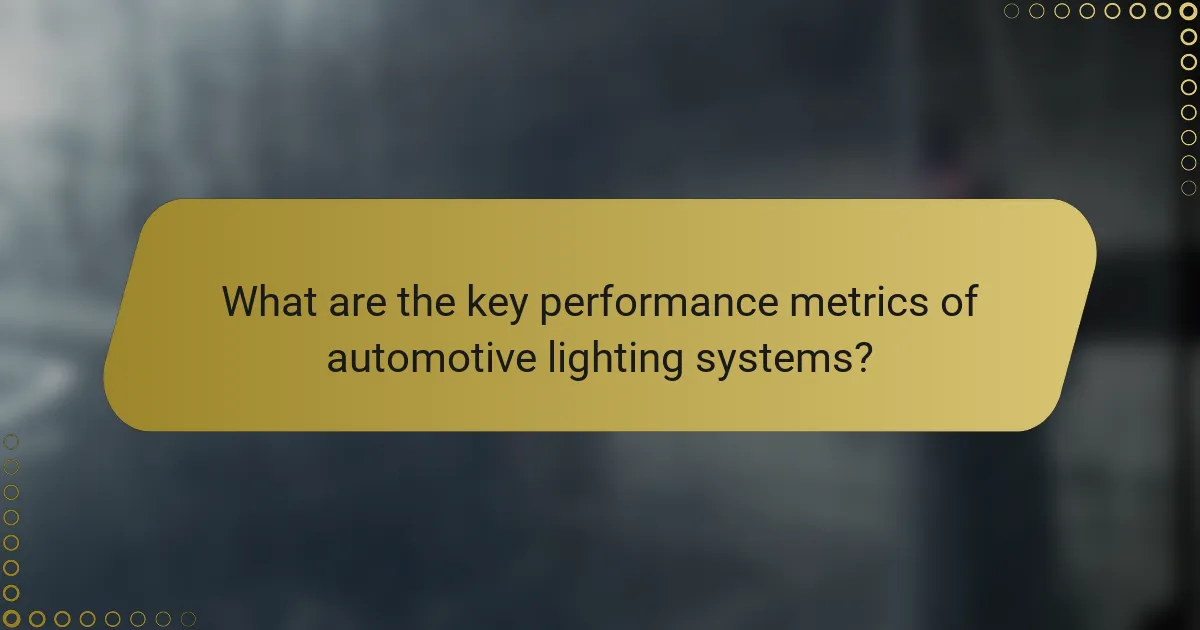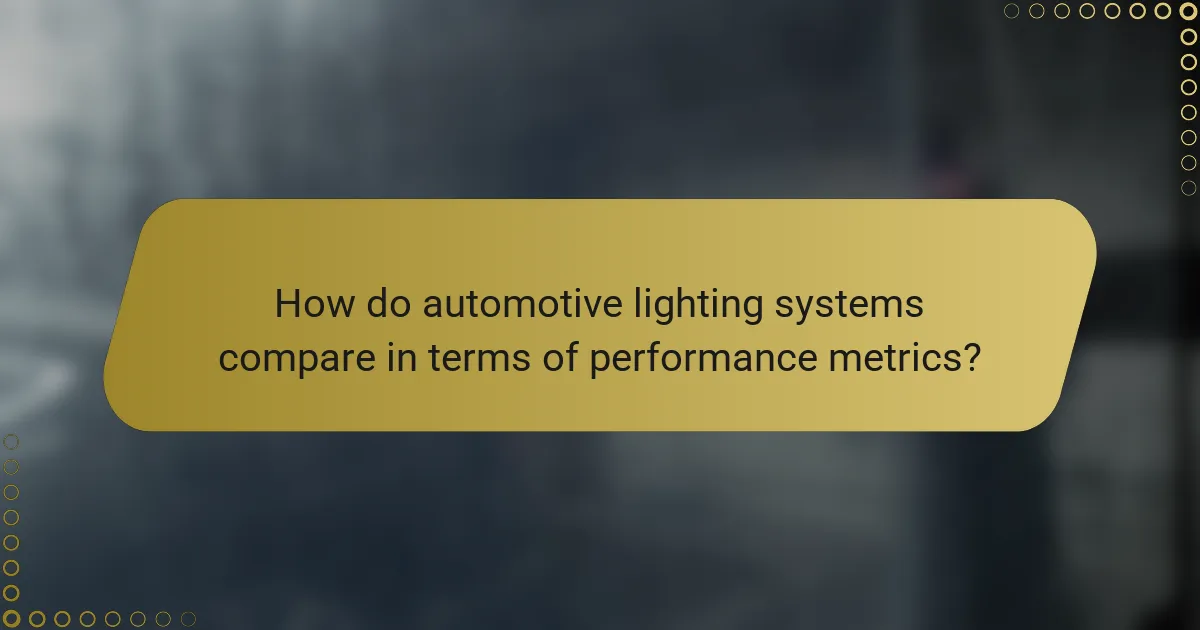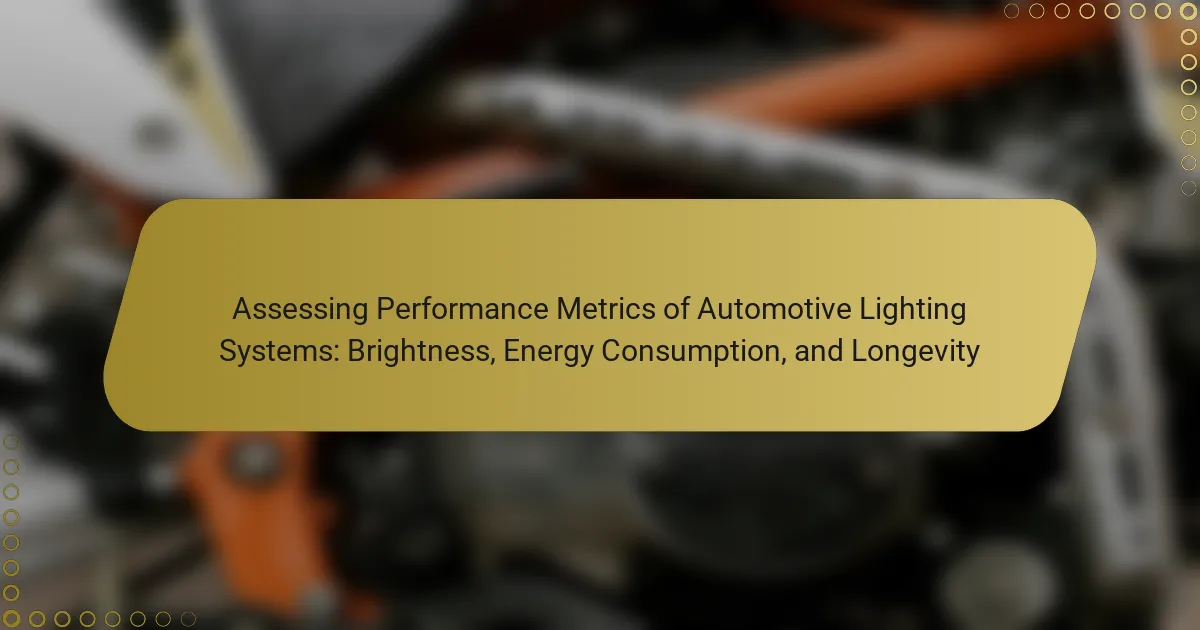The article focuses on the performance metrics of automotive lighting systems, specifically brightness, energy consumption, and longevity. Brightness, measured in lumens, indicates light output, while energy consumption, assessed in watts, reflects system efficiency. Longevity, typically measured in hours, represents the lifespan of lighting components. The article compares different lighting technologies, including LED, halogen, and HID systems, highlighting their respective advantages in terms of brightness, energy efficiency, and lifespan. Best practices for evaluating and optimizing these systems are also discussed, emphasizing the importance of regular maintenance and the use of adaptive lighting technologies to enhance safety and reduce energy costs.

What are the key performance metrics of automotive lighting systems?
Key performance metrics of automotive lighting systems include brightness, energy consumption, and longevity. Brightness is measured in lumens and indicates the light output. Energy consumption is assessed in watts, reflecting the efficiency of the lighting system. Longevity refers to the lifespan of the lighting components, typically measured in hours. High-quality automotive lighting systems provide optimal brightness while minimizing energy usage. For instance, LED lights can offer over 30,000 hours of lifespan. These metrics are critical for enhancing visibility and safety on the road.
How is brightness measured in automotive lighting systems?
Brightness in automotive lighting systems is measured in lumens. Lumens quantify the total amount of visible light emitted by a source. This measurement provides a standard for comparing the brightness of different lighting technologies. For example, a standard halogen bulb may emit around 1,200 lumens, while an LED bulb can produce over 2,500 lumens. The higher the lumen output, the brighter the light. Additionally, automotive lighting systems may also be assessed using lux, which measures light intensity per unit area. This helps determine how effectively the light illuminates the road. Brightness measurements are crucial for ensuring safety and visibility in various driving conditions.
What are the different units of measurement for brightness?
The different units of measurement for brightness include lumens, candelas, and lux. Lumens measure the total amount of visible light emitted by a source. Candelas quantify the intensity of light in a specific direction. Lux measures illuminance, or how much light falls on a surface area. Each unit serves a distinct purpose in assessing lighting performance. For instance, lumens are crucial for evaluating the brightness of automotive headlights. Candelas are important for understanding the visibility of lights from various angles. Lux is essential for determining how well-lit a space is. These units are standardized by organizations such as the International System of Units (SI).
How does brightness impact visibility and safety?
Brightness directly affects visibility and safety by enhancing the ability to see objects clearly. Higher brightness levels improve the driver’s perception of road conditions and obstacles. This leads to quicker reaction times in critical situations. Studies show that adequate brightness can reduce accident rates significantly. For instance, a well-lit environment allows drivers to detect pedestrians and other vehicles sooner. The National Highway Traffic Safety Administration indicates that proper lighting can decrease nighttime crash risks by up to 50%. Therefore, sufficient brightness is essential for ensuring safety on the roads.
What role does energy consumption play in automotive lighting systems?
Energy consumption is critical in automotive lighting systems as it directly impacts vehicle efficiency and performance. High energy consumption can lead to increased fuel usage in combustion engine vehicles. In electric vehicles, excessive energy use can reduce driving range. Efficient lighting systems, such as LEDs, consume less power while providing adequate brightness. This efficiency contributes to overall vehicle energy management. Studies show that LED headlights can reduce energy consumption by up to 75% compared to traditional halogen bulbs. Lower energy consumption also results in less heat generation, enhancing the longevity of lighting components. Therefore, managing energy consumption is essential for optimizing automotive lighting systems.
How is energy consumption quantified in automotive lighting?
Energy consumption in automotive lighting is quantified in watts (W). This measurement indicates the rate at which electrical energy is used by the lighting system. Each type of automotive light, such as halogen, LED, or HID, has a specific wattage rating. For example, a standard halogen bulb typically consumes around 55 watts. In contrast, an LED headlight may only use about 20 watts for similar brightness levels. The overall energy consumption can be calculated by multiplying the wattage by the hours of operation. This quantification is critical for assessing energy efficiency and optimizing vehicle performance.
What are the implications of energy-efficient lighting on vehicle performance?
Energy-efficient lighting positively impacts vehicle performance. It reduces energy consumption, leading to improved fuel efficiency. For instance, LED lights consume up to 75% less energy than traditional halogen bulbs. This reduction in energy demand allows for more efficient operation of the vehicle’s electrical systems. Additionally, energy-efficient lighting typically has a longer lifespan, reducing maintenance costs and downtime. Studies show that vehicles equipped with energy-efficient lighting can experience a decrease in overall operating costs. Furthermore, improved lighting quality enhances visibility, contributing to safer driving conditions. Enhanced visibility can lead to reduced accident rates, further benefiting vehicle performance.
Why is longevity an important metric for automotive lighting systems?
Longevity is a critical metric for automotive lighting systems because it directly impacts safety, cost efficiency, and maintenance. Longer-lasting lighting systems reduce the frequency of replacements. This minimizes downtime and enhances vehicle reliability. Additionally, longevity contributes to lower overall ownership costs. For example, LED headlights can last up to 25,000 hours, significantly outpacing traditional halogen bulbs. This extended lifespan means fewer resources are consumed in manufacturing and disposal. Furthermore, consistent illumination over time ensures optimal visibility for drivers. Reliable performance is essential for safe driving conditions. Therefore, longevity is a vital attribute in evaluating the effectiveness of automotive lighting systems.
What factors influence the lifespan of automotive lighting systems?
The lifespan of automotive lighting systems is influenced by several key factors. These factors include the type of lighting technology used, such as halogen, LED, or HID. Each technology has a different average lifespan, with LEDs typically lasting longer than halogens.
Operating conditions also play a significant role. Extreme temperatures, humidity, and exposure to vibrations can shorten the lifespan of these systems. Additionally, the quality of the components used in manufacturing affects durability. Higher quality materials generally lead to a longer lifespan.
Electrical factors, such as voltage fluctuations and power surges, can damage lighting systems and reduce their lifespan. Regular maintenance and proper installation are crucial for optimal performance. Poor installation can lead to premature failures due to misalignment or improper connections.
According to a study by the SAE International, LED headlights can last up to 25,000 hours, compared to halogen bulbs which typically last around 1,000 hours. This highlights the importance of technology choice in determining lifespan.
How does longevity affect maintenance and replacement costs?
Longevity significantly reduces maintenance and replacement costs in automotive lighting systems. Longer-lasting lights require fewer replacements over time. This decrease in frequency leads to lower labor costs associated with installation. Additionally, durable lighting systems minimize the need for ongoing maintenance checks. For example, LED lights can last up to 25,000 hours, compared to traditional bulbs that last about 1,000 hours. This extended lifespan translates into substantial savings. Lower replacement rates also mean less waste and environmental impact. Overall, longevity provides a clear economic advantage in the automotive lighting sector.

How do automotive lighting systems compare in terms of performance metrics?
Automotive lighting systems vary in performance metrics such as brightness, energy consumption, and longevity. LED systems typically offer higher brightness levels compared to halogen and HID systems. Energy consumption is lower for LEDs, consuming about 75% less power than halogens. Longevity is significantly greater for LEDs, lasting up to 25,000 hours versus 1,000 hours for halogens. HID lights provide a middle ground in brightness and longevity, lasting around 2,000 hours. These comparisons highlight the efficiency and effectiveness of different automotive lighting technologies.
What are the different types of automotive lighting systems available?
There are several types of automotive lighting systems available. These include halogen, LED, and xenon (HID) lighting systems. Halogen lights are traditional and widely used in vehicles. They provide good brightness but consume more energy compared to newer technologies. LED lights are energy-efficient and have a longer lifespan. They offer various colors and designs, making them popular in modern vehicles. Xenon lights produce a bright, white light and are often used in high-end vehicles. Each lighting system has its own advantages and drawbacks, impacting performance metrics like brightness and energy consumption.
How do halogen, LED, and HID systems differ in performance metrics?
Halogen, LED, and HID systems differ significantly in performance metrics such as brightness, energy consumption, and longevity. Halogen lights typically produce around 1,500 lumens per bulb. They consume about 55-100 watts of power. Their lifespan averages 500-1,000 hours. LED lights offer higher efficiency, generating 800-1,600 lumens while consuming only 10-20 watts. They can last from 15,000 to 25,000 hours. HID lights shine brighter, with outputs ranging from 3,000 to 4,000 lumens and consuming 35-85 watts. Their lifespan is also substantial, averaging 2,000 to 3,500 hours. This data illustrates that LEDs provide the best longevity and energy efficiency, while HIDs excel in brightness.
What advantages and disadvantages do each type present?
Automotive lighting systems include halogen, LED, and HID types. Each type presents distinct advantages and disadvantages.
Halogen lights are inexpensive and easy to replace. They offer good color rendering but have lower energy efficiency. Their lifespan is shorter, averaging around 1,000 hours.
LED lights are highly energy-efficient and have a long lifespan, often exceeding 25,000 hours. They provide bright illumination and faster response times. However, they can be more expensive upfront and may require specific fixtures.
HID lights produce intense brightness and have a longer lifespan than halogen, typically around 2,000 hours. They are more efficient than halogen but can have a slower warm-up time. HID systems can also be costly and require special ballasts.
In summary, halogen lights are affordable but less efficient. LED lights are efficient and long-lasting but pricier. HID lights offer brightness and longevity but come with higher costs and specific requirements.
How do environmental factors influence performance metrics?
Environmental factors significantly influence performance metrics of automotive lighting systems. Temperature affects energy consumption; higher temperatures can lead to increased energy use. Humidity can impact the longevity of lighting systems by causing corrosion. Dust and dirt accumulation can reduce brightness by obstructing light output. Additionally, exposure to UV light can degrade materials, affecting both brightness and longevity. Studies show that automotive lighting systems perform optimally within specific environmental conditions. For example, a study published in the Journal of Automotive Engineering highlights that performance metrics vary significantly with changes in temperature and humidity levels.
What impact does temperature have on brightness and longevity?
Temperature significantly affects both brightness and longevity in automotive lighting systems. Higher temperatures can lead to decreased brightness due to thermal degradation of components. For instance, LED lights may experience reduced light output as heat increases. Conversely, lower temperatures can enhance brightness temporarily but may also prolong the lifespan of the lighting system.
Longevity is impacted as elevated temperatures accelerate aging and failure rates of bulbs and LEDs. Research indicates that operating at optimal temperatures can extend the life of lighting systems by up to 50%. Maintaining proper thermal management is crucial for maximizing both brightness and longevity in automotive lighting systems.
How does humidity affect energy consumption in automotive lighting?
Humidity affects energy consumption in automotive lighting by influencing the efficiency of lighting systems. High humidity can lead to increased resistance in electrical components. This resistance can cause lights to draw more power to maintain brightness. Additionally, moisture can affect the performance of light sources, such as LEDs, leading to reduced efficiency. Studies indicate that increased humidity levels correlate with higher energy usage in automotive lighting systems. For instance, a study published in the Journal of Automotive Engineering found that energy consumption increased by approximately 15% in high humidity conditions compared to dry environments.

What are the best practices for assessing and optimizing automotive lighting systems?
The best practices for assessing and optimizing automotive lighting systems include evaluating brightness, energy consumption, and longevity. Brightness can be measured using a photometer to ensure compliance with regulatory standards. Energy consumption should be analyzed through wattage measurements during operation. Longevity can be assessed by tracking the lifespan of bulbs and LEDs through usage data. Regular maintenance checks are essential for identifying any performance degradation. Additionally, using adaptive lighting technologies can improve efficiency and effectiveness. Implementing these practices can enhance safety and reduce energy costs in automotive lighting systems.
How can vehicle owners maintain optimal performance of their lighting systems?
Vehicle owners can maintain optimal performance of their lighting systems by regularly checking and replacing bulbs. This ensures that lights remain bright and functional. Additionally, cleaning the lenses helps improve light output by removing dirt and grime. Inspecting wiring and connections prevents electrical issues that can affect performance. Ensuring that the lighting system is properly aligned maximizes visibility and safety. Regularly testing the lighting system, including turn signals and brake lights, ensures all components are working correctly. Following these maintenance practices can enhance the longevity and effectiveness of automotive lighting systems.
What routine checks should be performed to ensure effective lighting?
Routine checks for effective lighting include inspecting bulb functionality, ensuring proper alignment, and checking for lens clarity. Regularly test each bulb to confirm it is operational. Misaligned headlights can reduce visibility; adjust them to manufacturer specifications. Clean lenses to remove dirt and debris, which can obstruct light output. Additionally, examine wiring and connections for wear or corrosion. Verify that the lighting system meets regulatory standards for brightness. Conduct these checks periodically to maintain optimal performance and safety.
How can upgrades enhance the performance metrics of automotive lighting?
Upgrades can enhance the performance metrics of automotive lighting by improving brightness, reducing energy consumption, and increasing longevity. For instance, LED upgrades can produce significantly brighter light output compared to traditional halogen bulbs. Studies show that LEDs can be up to 200% brighter, improving visibility and safety. Additionally, LED lighting consumes up to 75% less energy than halogen options, which leads to lower fuel consumption in vehicles. Furthermore, LED lights have a lifespan of approximately 25,000 hours, compared to only 1,000 hours for halogen bulbs. This extended lifespan reduces the frequency of replacements, resulting in lower maintenance costs. Thus, upgrades to automotive lighting systems can significantly enhance overall performance metrics.
What common troubleshooting tips can help with automotive lighting issues?
Check the bulb to ensure it is not burned out. A burned-out bulb is a common issue causing lighting failure. Replace any faulty bulbs with new ones. Inspect the wiring for any signs of damage or corrosion. Damaged wiring can disrupt the electrical flow. Ensure all connections are secure and free from corrosion. Loose or corroded connections can lead to intermittent lighting issues. Test the fuses related to the lighting system. A blown fuse can cause specific lights to malfunction. Use a multimeter to check for voltage at the light socket. This can help identify if the problem lies within the power supply. If problems persist, consult a professional for further diagnosis.
How can issues with brightness be diagnosed and resolved?
To diagnose and resolve issues with brightness in automotive lighting systems, first inspect the light source for damage or wear. Check the bulb or LED for any signs of malfunction. Ensure proper electrical connections are intact and free from corrosion. Measure the voltage supplied to the lighting system; it should meet manufacturer specifications. If the voltage is low, trace the wiring for faults or shorts. Evaluate the lens or housing for dirt or obstructions that may affect light output. Cleaning or replacing the lens can improve brightness. Additionally, consider the ambient light conditions; excessive external light can diminish perceived brightness. Regular maintenance can prevent brightness issues from arising.
What steps can be taken to improve energy efficiency in lighting systems?
To improve energy efficiency in lighting systems, implement LED technology. LEDs consume up to 75% less energy than traditional incandescent bulbs. Utilize smart lighting controls to adjust brightness based on occupancy. Motion sensors can reduce energy use in unoccupied spaces. Regular maintenance ensures fixtures operate at optimal efficiency. Clean light fixtures to maximize output and reduce energy waste. Consider daylight harvesting by using natural light to supplement artificial lighting. Lastly, perform energy audits to identify areas for improvement and monitor consumption.
The main entity of this article is automotive lighting systems, which are evaluated based on key performance metrics such as brightness, energy consumption, and longevity. The article provides an in-depth analysis of how brightness is quantified in lumens and its impact on visibility and safety, along with the significance of energy efficiency in reducing fuel consumption and enhancing vehicle performance. Additionally, it discusses the importance of longevity in minimizing maintenance costs and improving reliability. Various lighting technologies, including halogen, LED, and HID, are compared in terms of their performance metrics, advantages, and disadvantages, along with best practices for optimizing and maintaining these systems.
